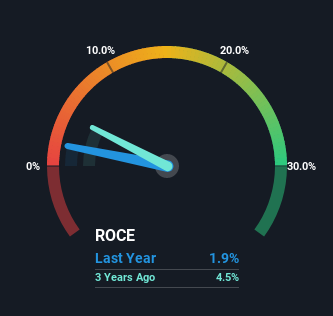- Malaysia
- /
- Auto Components
- /
- KLSE:AFUJIYA
These Return Metrics Don't Make ABM Fujiya Berhad (KLSE:AFUJIYA) Look Too Strong
What underlying fundamental trends can indicate that a company might be in decline? More often than not, we'll see a declining return on capital employed (ROCE) and a declining amount of capital employed. Ultimately this means that the company is earning less per dollar invested and on top of that, it's shrinking its base of capital employed. So after glancing at the trends within ABM Fujiya Berhad (KLSE:AFUJIYA), we weren't too hopeful.
What Is Return On Capital Employed (ROCE)?
If you haven't worked with ROCE before, it measures the 'return' (pre-tax profit) a company generates from capital employed in its business. To calculate this metric for ABM Fujiya Berhad, this is the formula:
Return on Capital Employed = Earnings Before Interest and Tax (EBIT) ÷ (Total Assets - Current Liabilities)
0.019 = RM3.4m ÷ (RM395m - RM215m) (Based on the trailing twelve months to March 2023).
Thus, ABM Fujiya Berhad has an ROCE of 1.9%. In absolute terms, that's a low return and it also under-performs the Auto Components industry average of 9.4%.
View our latest analysis for ABM Fujiya Berhad

Historical performance is a great place to start when researching a stock so above you can see the gauge for ABM Fujiya Berhad's ROCE against it's prior returns. If you'd like to look at how ABM Fujiya Berhad has performed in the past in other metrics, you can view this free graph of past earnings, revenue and cash flow.
What Does the ROCE Trend For ABM Fujiya Berhad Tell Us?
We are a bit worried about the trend of returns on capital at ABM Fujiya Berhad. Unfortunately the returns on capital have diminished from the 5.3% that they were earning five years ago. Meanwhile, capital employed in the business has stayed roughly the flat over the period. Companies that exhibit these attributes tend to not be shrinking, but they can be mature and facing pressure on their margins from competition. So because these trends aren't typically conducive to creating a multi-bagger, we wouldn't hold our breath on ABM Fujiya Berhad becoming one if things continue as they have.
On a side note, ABM Fujiya Berhad's current liabilities have increased over the last five years to 54% of total assets, effectively distorting the ROCE to some degree. Without this increase, it's likely that ROCE would be even lower than 1.9%. And with current liabilities at these levels, suppliers or short-term creditors are effectively funding a large part of the business, which can introduce some risks.
In Conclusion...
In the end, the trend of lower returns on the same amount of capital isn't typically an indication that we're looking at a growth stock. Investors haven't taken kindly to these developments, since the stock has declined 20% from where it was five years ago. That being the case, unless the underlying trends revert to a more positive trajectory, we'd consider looking elsewhere.
ABM Fujiya Berhad does come with some risks though, we found 4 warning signs in our investment analysis, and 3 of those are concerning...
While ABM Fujiya Berhad may not currently earn the highest returns, we've compiled a list of companies that currently earn more than 25% return on equity. Check out this free list here.
New: Manage All Your Stock Portfolios in One Place
We've created the ultimate portfolio companion for stock investors, and it's free.
• Connect an unlimited number of Portfolios and see your total in one currency
• Be alerted to new Warning Signs or Risks via email or mobile
• Track the Fair Value of your stocks
Have feedback on this article? Concerned about the content? Get in touch with us directly. Alternatively, email editorial-team (at) simplywallst.com.
This article by Simply Wall St is general in nature. We provide commentary based on historical data and analyst forecasts only using an unbiased methodology and our articles are not intended to be financial advice. It does not constitute a recommendation to buy or sell any stock, and does not take account of your objectives, or your financial situation. We aim to bring you long-term focused analysis driven by fundamental data. Note that our analysis may not factor in the latest price-sensitive company announcements or qualitative material. Simply Wall St has no position in any stocks mentioned.
About KLSE:AFUJIYA
ABM Fujiya Berhad
An investment holding company, manufactures and sells automotive batteries and batteries for storage and electrical application in Malaysia.
Slight risk with imperfect balance sheet.
Market Insights
Community Narratives


Recently Updated Narratives

Constellation Energy Dividends and Growth

CoreWeave's Revenue Expected to Rocket 77.88% in 5-Year Forecast

Bisalloy Steel Group will shine with a projected profit margin increase of 12.8%
Popular Narratives


MicroVision will explode future revenue by 380.37% with a vision towards success


NVDA: Expanding AI Demand Will Drive Major Data Center Investments Through 2026



